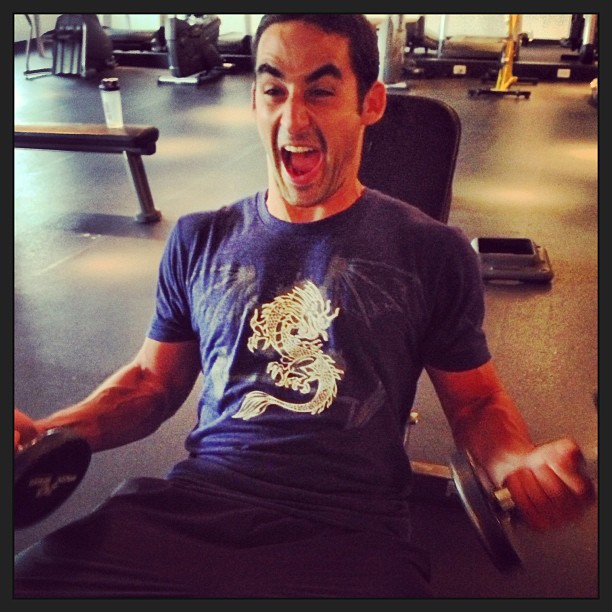Never “Just Give a Workout”
Today’s guest post comes to you from my good buddy Jonathan Goodman, head honcho at the Personal Training Development Center and globe-trotting ex-pat Canadian.
*****
“X” walked into my office nervously. Well, his name wasn’t actually X but I’m going to call him X because I don’t want to say his real name.
After talking about how Tiger Woods was a better golfer than Vijay Singh, I brought up his fitness goals. Having been in this situation so many times before I figured that X would tell me that he wanted to lose 10lbs or some generic goal at which point I would dig deeper.
“I just want a program,” he said.
For the next 5 minutes, X told me all about his experience in the gym. He played football in high school, hurt his knee with a previous personal trainer, had been in the gym on and off for the past 12 years, and had been consistently frustrated with his lack of results.
So he just wanted a program because he thought that it was the missing element. Media hype and the desire for a magic pill had led X to believe that a scientifically advanced program was the answer.
X was ready to pay me $500 to write him a program – a program that would’ve taken 1-2hrs to write.
I said no.
You Should Never “Just Give a Workout”
For most of our clients, the reason that they aren’t getting results is a combination of poor form, lack of consistency, bad nutrition, and no focus on the mind/muscle connection.
It’s not the program.
X had an alpha personality. I could tell from the minute he sat down that he had a hard time relinquishing control. As a result, he had never had good instruction in the weight room. My guess is that his strong personality intimidated his previous trainer and shifted the power of the relationship. Another program before learning to control the weight wouldn’t do him any good.
While I believe that part of a personal trainers job is to provide a program, the majority of our clients need a strong baseline established before advanced programming is considered.
My response to X was that he had two options:
- Save your money and purchase a magazine. If you just want a program, the workouts in there are just as good as anything I could write blindly.
- Train with me a minimum of twice a week for at least a month. At that point, if you like, I’ll provide you with a program with occasional check-ins.
For X, I said twice a week for a month because he had decent experience in the gym. For beginner clients, I’ll usually tell them that they must train with me at least 3x/week for the first month.
Managing expectations is important in this job. The adherence to most programs is embarrassingly low. The odds that somebody who “just wants a program” will comply at a minimum of 80% are not good.
The job of a trainer is to get to know an individual’s body – this takes time. Unless I spend a good amount of time with a client, the program I can build specific to them is probably no better than one they can find in a magazine.
So I’m honest. If a client just wants a program, I’ll tell them why I don’t think it’s a good idea and justify it to them with the reasons I’ll speak about in a minute. If they still just want a program, I’ll usually refer them to a program that suits their goals I found on a website or magazine and wish them well.
Associative Learning
In my Focus System that I describe in detail in Ignite the Fire, I discuss the concept of associative learning. Simply put, there’s just too much information for our brains to process if it had to do everything from scratch.
As a result, our brain makes assumptions based on past experiences to conserve energy. This happens with movement but also with mental processes.
Imagine you see a triangle shaped object with 3 wheels moving on the road. You’ve never seen or heard of this object but immediately you identify it as a car. Why?
Well, it has wheels and a structure that could hold a person and it’s motoring down the road. Unconsciously your brain puts all these pieces together and concludes it’s a car based off of what it already knows. This takes less than a second and, for the most part, it’s an accurate process.
Motor learning is no exception.
A press is a press is a press. The same basic pattern exists when somebody is doing a single arm press while lying on a ball as it is with somebody doing a barbell bench press. Walk into a commercial gym and you’ll probably see circus exercises that you’ve never heard of before. I’d venture that, within two seconds, you’re able to break down the movement the person is performing and what general muscles it works.
[A note here: I know that I’m simplifying movement and understand and respect the importance of coordinated firing of motor units for improved movement patterns. It’s not a simple process but much of it is automatic. For the purposes of this article I’m not getting into the physiology of skill acquisition. High performance is very different and not under the scope of this article.]
Explaining this system to perspective clients who “just want a program” is important. You wouldn’t build a house without a strong base and learning strong movement patterns acts as the base for exercise.
If nothing else, I suggest ensuring that a client knows how to do a press, upper body pull, the squat pattern, and the deadlift pattern before giving them a program.
This also makes your job easier in the long run. Teach a client to press properly and you can later change the specifics of the exercise (i.e. an incline vs. flat) and they’ll pick it up within seconds.
Justifying it to a Client
I hope by now you agree with my argument towards never giving a client “just a program” but it can be a hard sell to the client.
There are a couple of analogies and points you can make.
The first is to compare a fitness program to a stone wheel. Here’s what I might say:
“It takes a lot of momentum to get it rolling but very little to maintain. At the beginning, it’s going to take a lot of support and tweaking of the program but once you’re rolling, I’m confidant you’ll have all of the tools to keep at it.”
Often a client will ask for a program because they think it’s going to cost less money.
In response, I suggest asking them how long they were planning on working with you on an ongoing basis. The answer will almost always require, at a minimum, ten sessions, even with just a program for a few cycles.
Tell them that it’s better for them to train with you 2-3x/wk (depending on their needs, but you decide this, not them) for the first month. Justify it to the client by saying that it’s the same number of sessions and investment but now they’ll have all the tools to move forward and a program.
After they do the initial sessions bundled up odds are that they’ll love the experience and already see results. At that point they’ll likely continue. Even if they don’t, you’ll have helped them more than charging for an overpriced program.
About the Author
Jonathan Goodman is the author of Ignite the Fire, a book that teaches how to become a personal trainer and build a successful career, and can rock a Dragon tee almost as well as I can. To learn more about his personal training books and free collaborative resource for trainers, go to the Personal Trainer Development Center.


One Response to Never “Just Give a Workout”